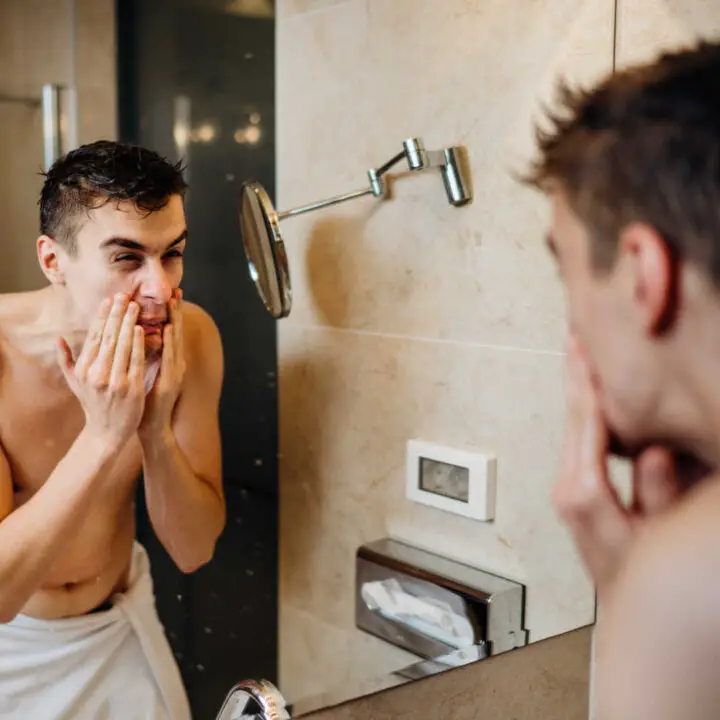
One of the pleasures of shaving is when you apply a good aftershave to your newly shaved face. The smoothness and the fragrance wrap up the shave and leave you feeling at the top of your game.
You probably have noticed that the fragrance from most aftershaves is short-lived. They smell great when you apply them, but by the time you are outside the fragrance has begun to fade, and by mid morning it’s gone altogether. No one wants to bowl people over with a heavy fragrance, but it can be nice to have a hint of the scent linger longer.
In this article, I’ll tell you some aftershave tricks I’ve discovered. One is how to use an eau de toilette (EDT) as an aftershave to get a fragrance that lasts longer — and what to do to counteract its drawbacks. Another trick is how to improve a regular aftershave splash’s effect on your skin (though that will not extend the lifespan of the scent).
But Do You Even Need An Aftershave?
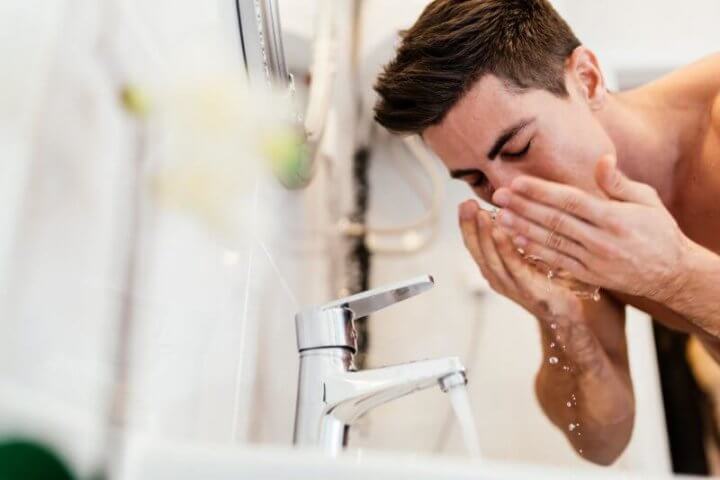
Some men just splash cold water on their face following their shave and are satisfied with that. Indeed, some men don’t even use shaving soap — they use only water, or they use bath soap.
However, most men prefer to use a soap specifically formulated for shaving because shaving soap provides a thicker lather, better protection, more glide, and a better fragrance than bath soap. I like to make repeated tasks enjoyable — if I must do something frequently, I take steps to make doing it a pleasure.
An aftershave will do more than cold water can. First, an aftershave can provide enjoyment through its fragrance and feel on your face. Second, an aftershave generally includes ingredients that improve the feel of your face, by moisturizing your skin and soothing any post-shave burn. Third, a good aftershave removes rawness and prepares you to face the day. (It will not, however, close the pores of your face. Pores do not have muscles that allow them to open or close. However, good skin care can make pores less noticeable by, for example, reducing skin irritation)
The most noticeable characteristic of an aftershave is probably its fragrance, but its contribution to skin care is perhaps more important. So I come down firmly in favor of using an aftershave. It offers fragrance, which cold water lacks, and it helps with skin care.
An EDT can bring a good and relatively long-lived fragrance, but for best results, we must add the skin-care component.
Aromatic Compounds
After you apply a fragrance, the lifespan of its scent depends mainly on the concentration of the aromatic compounds it contains. The aromatic compounds might include essential oils, fragrance oils, or hydrosols.
- Essential oils are extracted from plants, including herbs — from the blossoms, leaves, roots, or other tissues. These are complex and might include components that trigger allergic reactions in some people.
- Fragrance oils are manufactured. Synthetic fragrance oils might be derived from solvents, UV absorbers, dyes, or other chemicals. Natural fragrance oils are made by isolating a single component of an essential oil — for example, vanillin from vanilla or limonene from lemons. Because it uses only a single component, natural fragrance oils are not so likely as essential oils to trigger an allergy.
- Hydrosols, like essential oils, are derived from plants, but by means of distillation (steam distillation, usually), so hydrosols contain the water-soluble components and are much less concentrated than essential oils.
Fragrance Product Categories
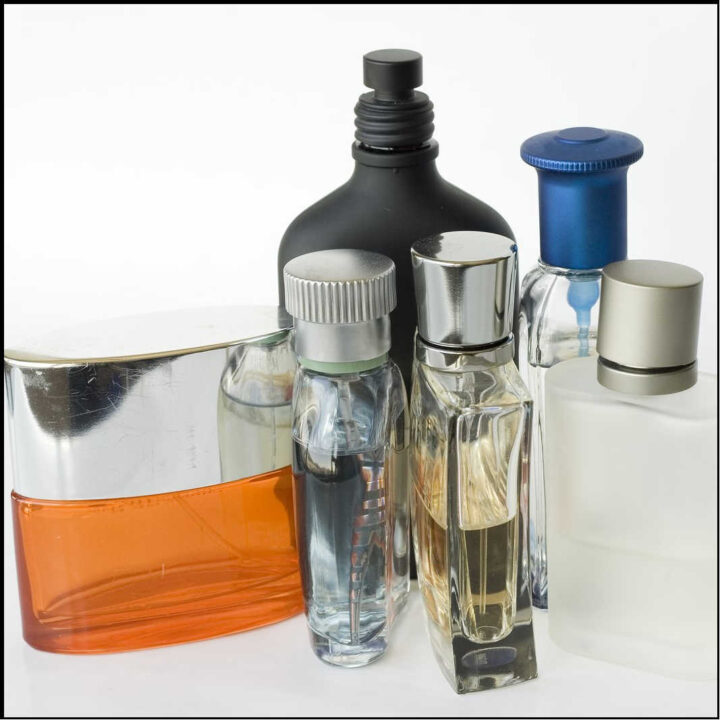
Fragrance products are a dilution of aromatic compounds, and product categories are defined by the degree of dilution. The less the dilution, the longer the scent persists and the less of the product is required. Some of the major categories, with the expected lifetime of their scent, are:
- parfum or extrait, AKA perfume extract, pure perfume, or simply perfume: 15–40% aromatic compounds (typically ~20%); 12 hours+
- eau de parfum (EDP): 10–20% aromatic compounds (typically ~15%); 10-12 hours
- eau de toilette (EDT): 5–15% aromatic compounds (typically ~10%); This product category is typical for masculine fragrances; 6-8 hours
- eau de Cologne (EDC), AKA simply cologne: 3–8% aromatic compounds (typically ~5%); 3-4 hours
- aftershave, varieties noted below; 1-3% aromatic compounds (typically ~2%); 2-3 hours
Aftershaves
[Editor’s Note: Amazon, Geni.us, Phoenix Artisan Accoutrements, and Smallflower links are affiliates.]
Aftershaves differ from the other fragrance categories in the list above. Along with aromatic compounds, aftershaves include ingredients for skincare, to soothe and moisturize the skin following a shave.
Aftershaves can roughly be divided into three main categories: splash, milk, and balm.
- Splash — an aftershave splash is a relatively thin liquid, often based on alcohol though some splashes use witch hazel instead (or in addition) because witch hazel is better for the skin than alcohol. Alcohol-based splashes will generally include ingredients to mitigate the effects of alcohol on the skin, such as glycerin. Witch-hazel-based splashes are better for the skin, and these also often include additional soothing and/or moisturizing ingredients such as aloe vera. For example, Thayers witch hazel with aloe vera is sometimes used as an aftershave. That brand is available as a toner (alcohol-free) or an astringent (10% alcohol). Thayers also makes a witch hazel specifically identified as an aftershave lotion (20% alcohol).
- Milk — an aftershave milk is somewhat thicker than a splash and not so thick as a balm. A milk will often include more skincare ingredients than a splash. For example, D.R. Harris After Shaving Milk.
- Balm — an aftershave balm is a thick liquid, sometimes more like a salve. Balms focus primarily on soothing, moisturizing, and skincare, though they also generally (though not always) include some fragrance. Thayers also offers an aftershave balm, which from the description I would describe as an aftershave milk, reserving “balm” for thicker preparations, such as Phoenix Artisan Accoutrements’s (PAA) Star Jellies.
It’s worth noting that splashes vary a lot in how kind they treat your skin. Some mass-market aftershaves (Aqua Velva, Skin Bracer, and the like) are heavy on alcohol and light on skincare and moisturizing ingredients. Others, like the Thayers splashes and some splashes made by artisanal soapmakers, include substantial skincare help along with little or no alcohol. Your best bet is to read the ingredient list to know what you are applying.
Some aftershaves are called “lotions.” That term is ambiguous and might be used for a splash or a milk, or even a balm.
Phoenix Artisan calls its aftershave splashes “aftershave/cologne,” with “cologne” implying a higher proportion of aromatic compounds. I have indeed noticed that the fragrance from a PA aftershave/cologne does last longer than that from a typical aftershave splash. But, as the “aftershave” in the name implies, these cologne/aftershaves differ from normal colognes by including skincare ingredients, such as aloe vera, glycerin, and seaweed extract.
Click/tap here for a more detailed discussion of aftershaves.
The Meanings Of “Cologne”
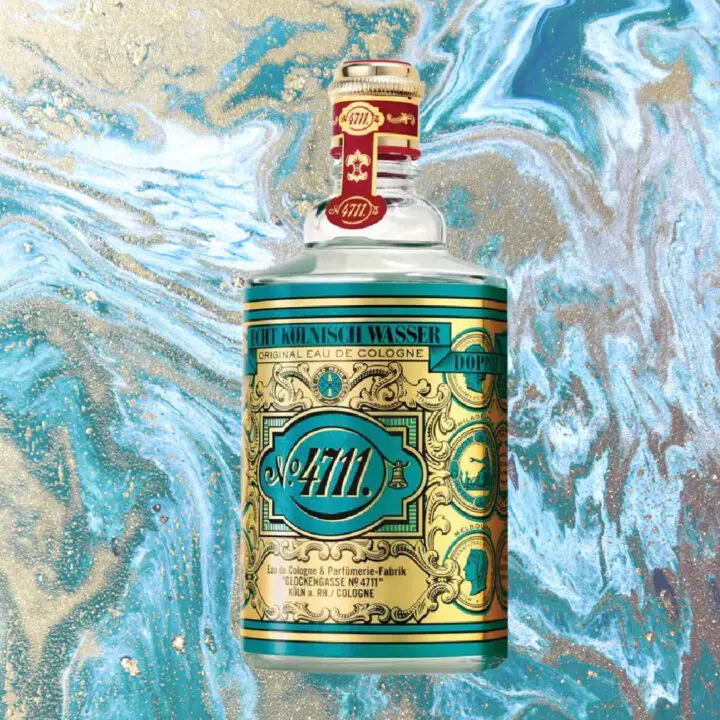
“Cologne” is somewhat ambiguous. Cologne was originally used to designate a family of fresh, citrus-based fragrances distilled from citrus, floral, and woody ingredients. These originated in the early 18th century in Cologne, Germany, thus the name. These colognes are not based on perfume oils. An example cologne in this sense is Mäurer & Wirtz’s 4711 (created in 1799), now available both as an aftershave and a cologne.
In the 20th century, “cologne” began to be used for fragrances with a specific range of concentrations of aromatic compounds, stronger than aftershave but not so strong as eau de toilette (EDT), as described above. In this usage, the starting point is typically a parfum, and the cologne is usually the lightest concentration available of a particular brand of fragrance.
The third meaning of “cologne” was to denote a fragrance typically worn by a man as opposed to a woman, regardless of its concentration. The idea apparently was that a man who would not respond favorably to “eau de toilette” would accept a product labeled “cologne.” This sense of the word seems to be on the wane since men today have no trouble using a fragrance labeled as an EDT.
EDT As Aftershave
You can use an EDT as an aftershave, taking steps to minimize its drawbacks in that role. But why would you want an EDT instead of a regular aftershave?
There are a couple of reasons. For one, a fragrance you like may not be available as an aftershave, but only as an EDT. Indeed, some fragrances once available as an aftershave now come only as an EDT or cologne. If you like the fragrance, using the EDT (or cologne) as an aftershave makes sense.
You also might want an aftershave whose fragrance lasts longer than the 2-3 hours typical of an aftershave. An EDT, whose scent lasts 6-8 hours, presents a possible solution. Even though diluting an EDT somewhat reduces the persistence of its scent, it still is likely to last longer than an aftershave.
The one stumbling block is that EDTs lack the soothing and skincare ingredients typically found in an aftershave. The solution: add skincare ingredients to the EDT yourself. You can do this in advance, by making up a bottle of EDT-based aftershave, or on the spot, as you apply the mix following your shave.
The problem with the batch method is that an EDT almost always comes with a spray dispenser, and the dispenser is generally permanently attached to the bottle. Another drawback to making a batch is that you might want to vary the proportion of EDT in the mix, depending on the occasion.
I gave up the idea of making a bottle batch of EDT aftershave, and here I discuss only the method where you combine EDT and skincare ingredients on the spot after the shave.
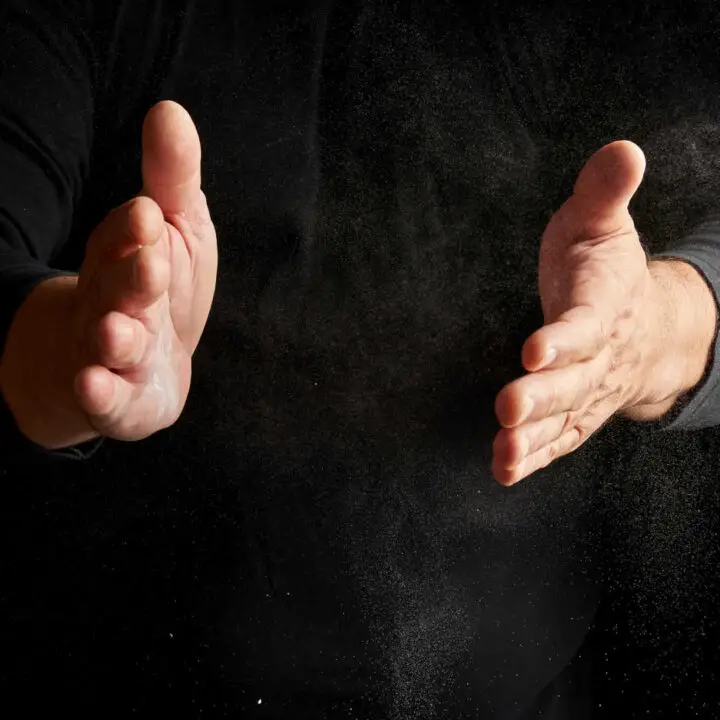
Option 1: Use The Edt Directly
If you’re willing to forego the skincare aspect of an aftershave, you can use an EDT directly, though I don’t recommend this. If you take this approach, I suggest diluting the EDT somewhat. Use a few sprays to make a small pool into the palm of your hand and then add a little water; or you can apply the EDT directly to your damp face following the final rinse.
Option 2: Mix The Edt With A Balm
This is the approach I most often use. Put a little of the balm in the palm of your hand, spray it several times with the EDT, rub your hands together to mix the two, then apply it to your face. Using this method lets you vary the fragrance strength to suit the day and your plans: more sprays for a longer-lived fragrance, fewer sprays for a lighter fragrance.
I recommend a scentless balm, like PAA’s Star Jelly Scentless Aftershave or Grooming Dept’s Hydrating Gel, but you can use instead a balm with a light fragrance, like Proraso White Balm.
Option 2a: Mix Your Aftershave Splash With A Balm
I routinely use a scentless balm with any aftershave splash that seems light on skincare — and in particular with any alcohol-based splash. Some mass-market aftershaves — Aqua Velva, Skin Bracer, and others — are long on alcohol and short on moisturizing ingredients. Those in particular I augment with a balm. In fact, unless the list of ingredients includes noticeable skincare assistance (like the aftershave splashes mentioned below), I’ll use a balm with the splash.
I pour a little aftershave into my palm, add a couple of squirts of Hydrating Gel, rub my hands together to mix, and apply. My idea is to mitigate the effect of alcohol on my skin and amp up the moisturizing.
I skip the balm if the aftershave splash seems to do a good job of skincare — splashes like those made by Tallow + Steel, Southern Witchcrafts, Van Yulay, and others. For example, Tallow + Steel aftershave splashes include witch hazel, aloe vera, glycerin, willow bark extract, and cucumber extract; Southern Witchcrafts aftershave splashes include shea butter, castor oil, glycerin, coconut oil, jojoba oil, and liquid aloe. Van Yulay aftershave splashes have no alcohol at all; their ingredients are aloe vera, witch hazel, Abyssinian seed-emu-red castor-evening primrose-rosehip seed oils, comfrey, calendula, oat, marshmallow, green tea extracts, liquid silk, and fragrance.
I highly recommend that you make it a practice to read the ingredients in your aftershave. You can then decide for yourself whether the skincare function needs a boost.
Option 3: Mix The Edt With A Neutral-Scent Splash
Another option is mixing the EDT with a skincare-oriented splash, choosing one that does not have much of a fragrance on its own. Two good candidates: Thayers Original Astringent (includes glycerin) or Thayers Gentlemen’s Aftershave Balm (includes glycerin, jojoba oil, coconut oil, and rosehip oil).
Pour a small amount of the splash into your palm, add several sprays of the EDT, rub your hands together to mix, and apply. Again, vary the number of sprays depending on the fragrance lifespan you want — more sprays = longer lifespan.
Does It Work?
I have found that using an EDT as an aftershave works well if skincare ingredients are added.. Because of the EDT’s relatively high concentration of aromatic compounds compared to an aftershave, it’s possible that some will have a mild skin reaction (for example, the skin turns red and hot for a while). But that issue is not specific to EDTs — skin reactions can occur with regular aftershaves as well. Sandalwood, for example, seems to trigger a skin reaction in some, whether in the shaving soap or the aftershave. Lime is another fragrance that affects some people’s skin.
The rule for any product used on your skin is to discontinue use if your skin reacts adversely, whether the product is a soap, aftershave, EDT, or anything else. So far, in my personal use I have not found EDT acts just like an aftershave splash, once I add some skincare ingredients.
In theory, some EDTs might work better than others, but in experimenting with a variety of them, I have not found any real differences in how they perform (other than the difference in fragrance). The main considerations are: a) pick a fragrance that you like; b) add some skincare ingredients as suggested above; and c) discontinue use if your skin reacts (and if it does, you would also not want to use it as an EDT).
I like that EDTs offer an increase in the range of fragrances available and in the durability of scent. Moreover, paying attention to the skincare issue has led me to a way to improve my regular aftershave splashes as well.

I have a fourth and fifth option. I regularly use plain witch hazel into which I have mixed a small amount of 100% aloe vera gel (it dissolves readily). Although witch hazel has a faint smell of its own, the scent disappears shortly after the product dries. Real witch hazel contains naturally occurring alcohol (about 14%) and other compounds that give it astringent and antiseptic properties similar to an aftershave splash. I mix in the aloe for a little more soothing effect.
As a fifth option, there is always the alum bar, which also has astringent and antiseptic properties, yet is virtually odorless.
I have used both of the above, either alone or in combination and neither will interfere with one’s EDT, which can be applied in its normal fashion, i.e. outside of the shaving ritual.
Excellent suggestions! Thanks for posting.
Comments are closed.